eing located in what was the very first neighborhood of Boston, my site has bared witness to countless natural processes across several centuries that have shaped it and transformed it, but also to several human directed projects that have modified its surroundings at a massive scale. In less than four hundred years, the geography of Boston has transformed from a barely populated small penninsula with a very narrow connection to the continent with only a handsome of settlements to a large full fledged modern city with a solid connection to te mainland. Several water boddies have been filled in by human hands to allow for further expansion; forests have been chopped, highways established, skyscrappers lifted, and inmense concrete jungles have been laid over the terrain. At the heart of Boston, the North End is one of the very few places that were established from the very begenning, and were present throughout all this journey, acompannying Boston throughout this historic voyage. The maps below serve to give an idea of the inmense geographical changes in the vicinity of Boston.
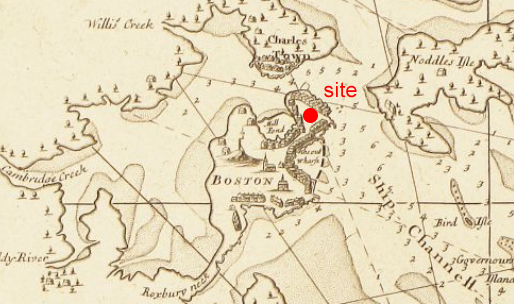 A map showing the early setting of Boston in the 18th century.
A map showing the early setting of Boston in the 18th century.
"A new sourvey of the harbor of Bsoton in New England". (London, crica 1706-1732). Web. Boston Rare Maps, http://www.bostonraremaps.com/catalogues/BRM1759.HTM .Accessed 7 March 2014.
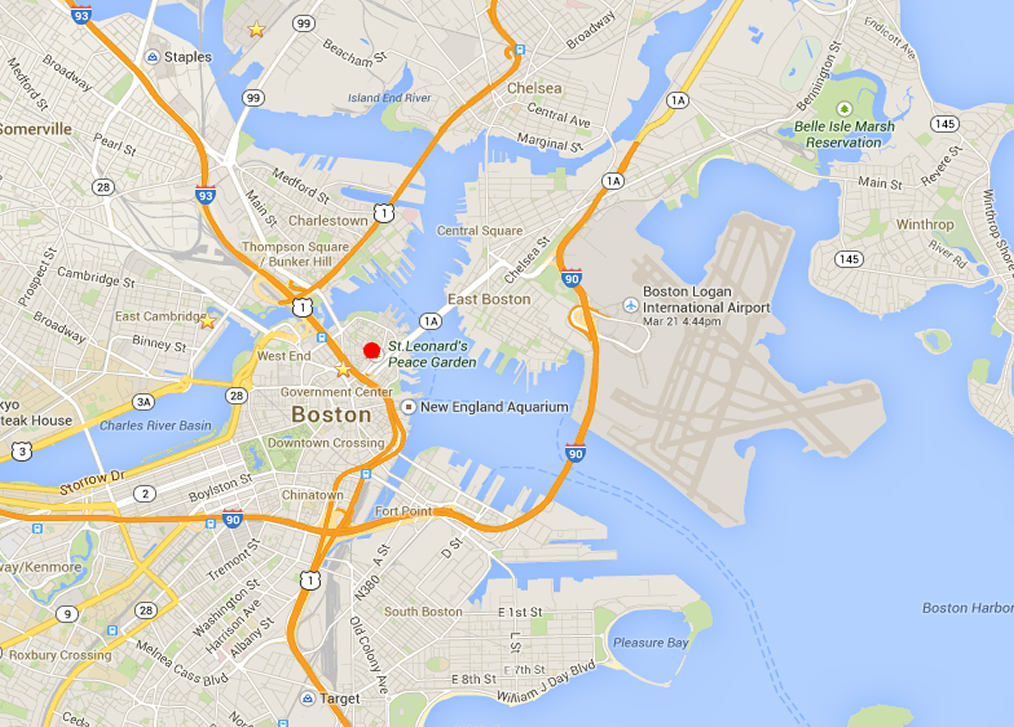 A current date map of Boston.
A current date map of Boston.
"Boston, MA." Google Maps. Google, 6 March 2014. Web. Accessed 7 March 2014.
Nowadays, the North End lays completely submerged in the concrete jungle that has covered these lands. It is a fairly populated area considered by many a landmark of Boston, but has made itself a reputation for its extreme urbaness and its almost absolute lack of folliage. The particular site that I have chosen might not be representative of this zone, since looking at any map can quickly confirm that it contains a couple of the most densely vegetated areas in North End, the most promminent one being the Paul Revere Mall, a large open park that immediately stands out among the densely packed housing and commercial complexes. However, the overall feel of the heavily urbanized zone that the North End is still predominates, even in my site.
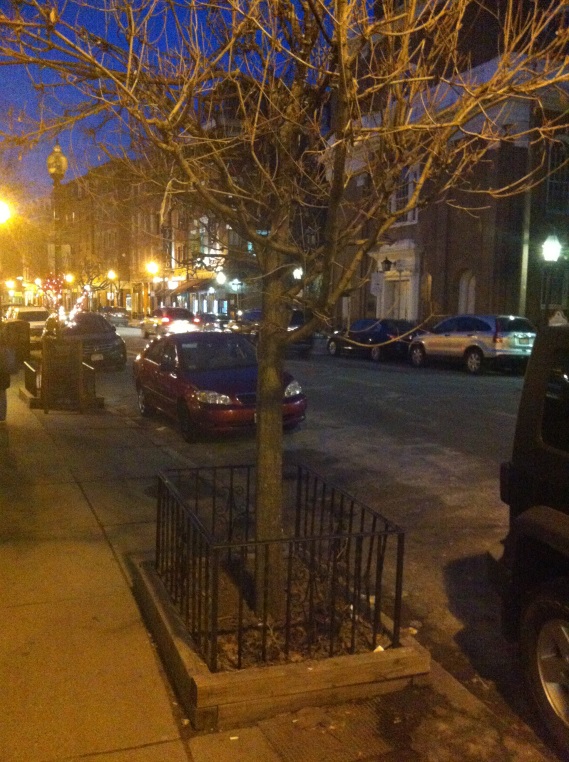 Planted in a very tight square of soil, this tree is effectively potted.
Planted in a very tight square of soil, this tree is effectively potted.
Entering the North End through Hanover Street, one quickly undergoes a transition from the fairly vegetated North End Park (which actually lies just in the border of North End) into the heart of North End itself, where such a large open space will be very hard to come by again. The transition is fairly ameliorated, however, by the fact that Hanover Street happens to be pretty much the only street in North End with a somewhat even distribution of street trees. This, however, is not to say a lot. The trees here are planted in very narrow spaces. The tree to the left, for example, is allowed just a tight square of soil over the sidewalk, resulting in it being effectively planted inside a concrete pot, its roots unable to grow and expand past that square area to collect nutrients and water. Under these very poor conditions, trees are barely able to grow, and one only observes very short and thin trunks. As Spirn writes in The Granite Garden, "Street trees, therefore, eke out a marginal existence, thei r roots cramped between buildings and street foundations, threaded among water, gas, electric, and telephone lines, and encased in soil as dense and infertile as concrete."(p.175).
These trees are also not very appropriately taken care of by anyone, since one can notice several of the concrete pots empty. Presumably, they once contained a tree just like the others, except the tree could not manage the struggle for survival in the city anymore and died out, with no one having replaced it or done something about the concrete pot to date. During the end of this winter season, it was also possible to spot some very weak trees that looked like they were at the brink of death. Interestingly, their soil patch did not seem unfertile, but rather completely soaked, the melting snow flooding their small pots. This might be after all what is causing the death of these trees, as it could be an example of what Spirn describes as "the teacup effect" (p.192): when the environment is very wet, the water can sink into these concrete pots. Then, surrounded by concrete, it is unable to drain anywhere, nor to be absorbed by the roots in its entirety, eventually resulting in the drowning of the tree. According to Spirn, this is a very common cause of death in newly planted trees.
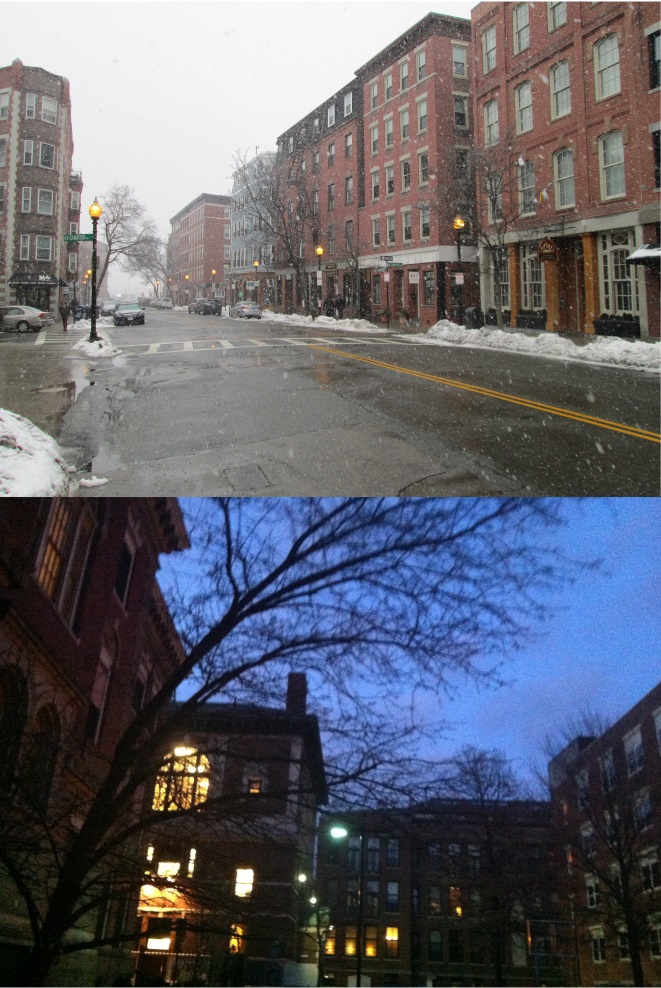 Trees in North End very commonly grow at extremely bent angle
Trees in North End very commonly grow at extremely bent angle
The strive of these trees for survival in the dense city environment that is North End is further complicated by the struggle for sunlight. Between big churches, tall buildings, and densely packed 3-story housing complexes, the short weak trees have very little chance to catch the sunlight that they required to get out of their pitiful situation. The extents of the problems that arise from this situation can become very clear when one observes the angles at which some of the trees planted in the sidewalks decide to grow. While it is somewhat normal to see trees in the cities growing bent towards the sunlight, one can observe some trees growing at extremely bent angles in North End that still manage to impress, desperately trying to get away from the tall buildings. A very peculiar tree, for example, lies next to St Stephen's church, right across the street from the Paul Revere Mall. Inconveniently planted in a position surrounded by the walls of the church, this tree receives very little sunlight and has grown in very weird curved patterns looking for it.
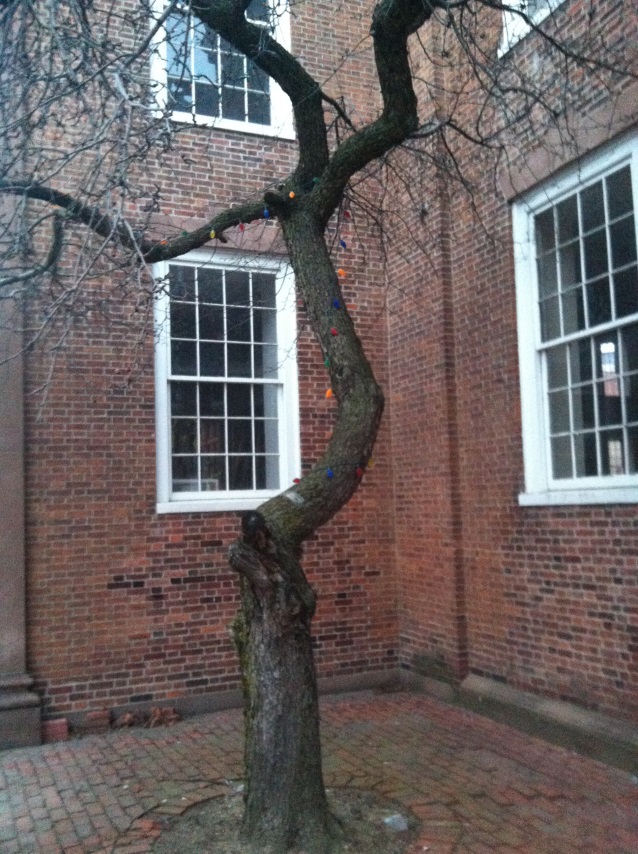 Confused by its unconvenient location, this poor tree has grown in all kinds of twisted directions in search for light
Confused by its unconvenient location, this poor tree has grown in all kinds of twisted directions in search for light
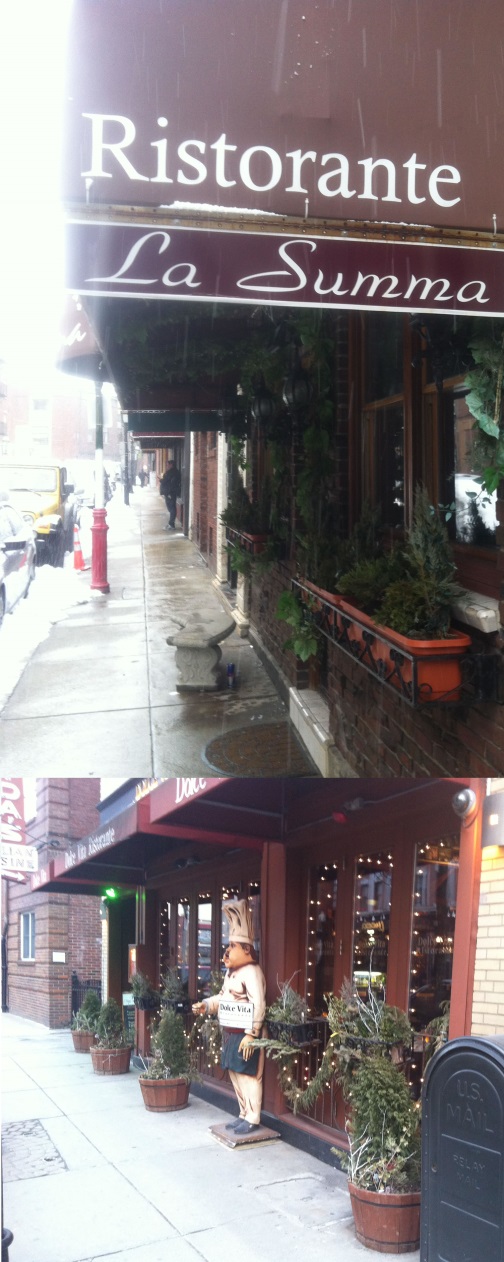 Restaurants throughout Hanover Street decorate their entrances with flowers and bushes
Restaurants throughout Hanover Street decorate their entrances with flowers and bushes
There are many problems associated with the disregard for foliage which are described by Spirn in chapter 8 of The Granite Garden, including increased heath in the climate, increased pollution and flooding, and decreased quality of water; at least a couple of which can be easily noticed to be very evident problems in North End just by walking through its streets. To lighten up the situation a little and create a more pleasant atmosphere, many establishment owners have taken it upon themselves to decorate Hanover Street with small plants outside their businesses that they themselves take care of. It is fairly common to see restaurants hang flowers from their entrances, making an effort to make them thrive even outdoors during the winter, or other businesses maintaining small bushes in pots near the sidewalk. Although it creates a very artificial-like and unrealistic environment, it is quite welcomed as an attempt to break the monotonicity of the large bed of concrete throughout North End, and it is a factor that plays a very important role in shaping the visual setting of Hanover Street.
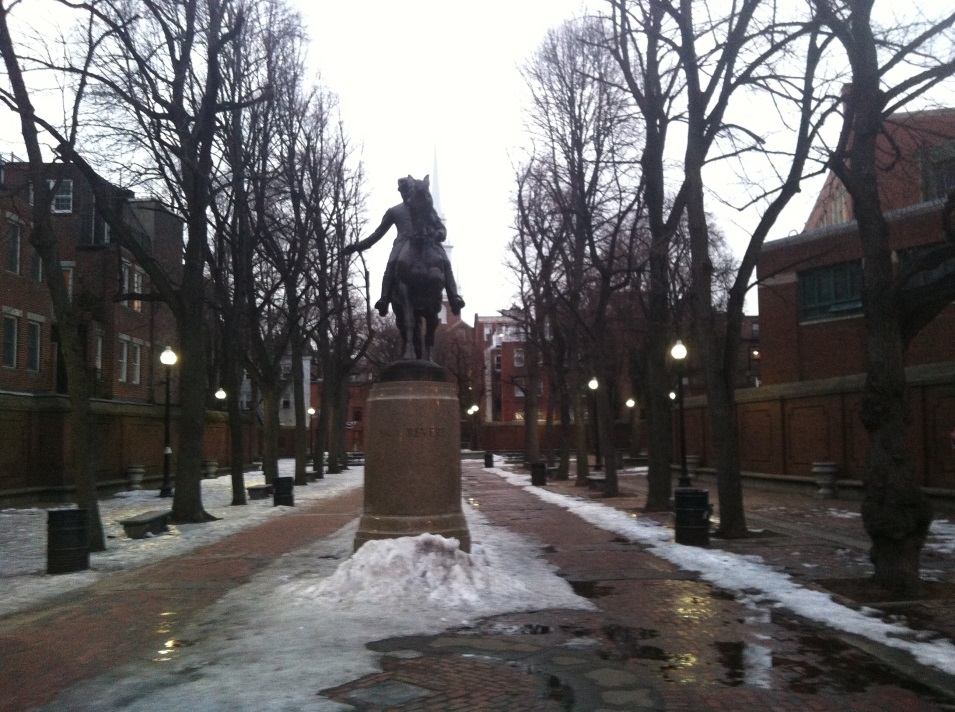 The Paul Revere Mall
The Paul Revere Mall
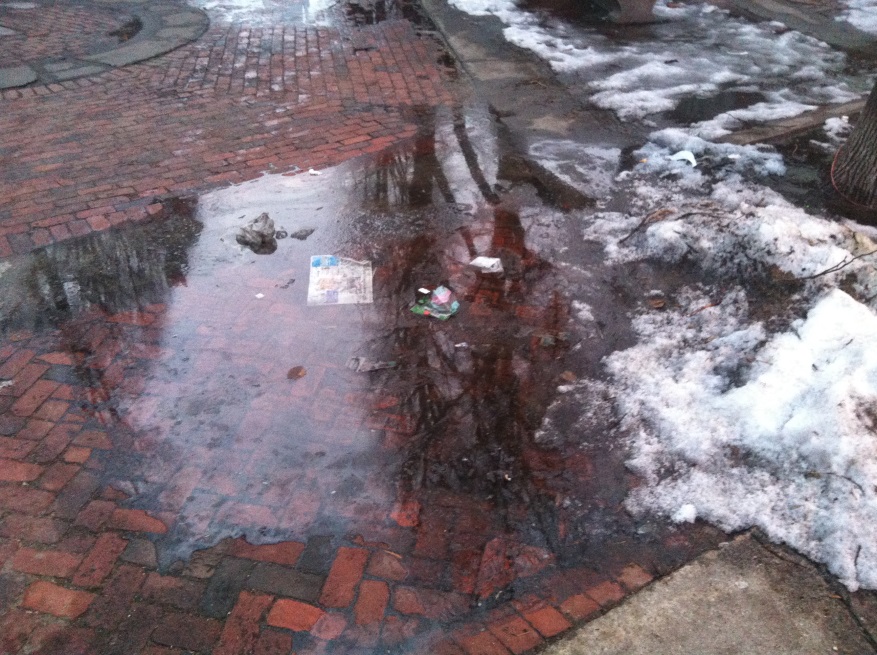 Molten snow creates a puddle of water that will not sink, a very common sight in the mall
Molten snow creates a puddle of water that will not sink, a very common sight in the mall
As one continues walking north through Hanover Street, the situation keeps looking even better as the Paul Revere mall shows itself. Surrounded by a very densely packed neighborhood and three story buildings everywhere, this large open space immediately calls for attention and seems like a very forced yet much needed attempt to give the neighborhood some air. The Paul Revere mall is a wide open, completely flat park with pleasant vegetation, very tall trees and plenty of benches; erected in honor of the revolution hero and featuring a large statue of him riding a horse in the center. Favored by the shade provided by the trees and the humidity of the coastal area, large quantities of moss grown in the walls and even over the trees themselves. Interestingly enough, however, the mall is not a conventional park in the sense of being located over a grassy garden, but is instead covered with bricks. This has a very unpleasant consequence during the winter, as I have found in each of my trips, which is that the mall gets very easily flooded once the snow starts melting. The brick bed and the wide, flat area of the mall make for a terrible combination; water from the molten snow accumulates in the park and just stays there, unable to drain anywhere. Puddles are almost always guaranteed to make anyone's stroll through the park a struggle.
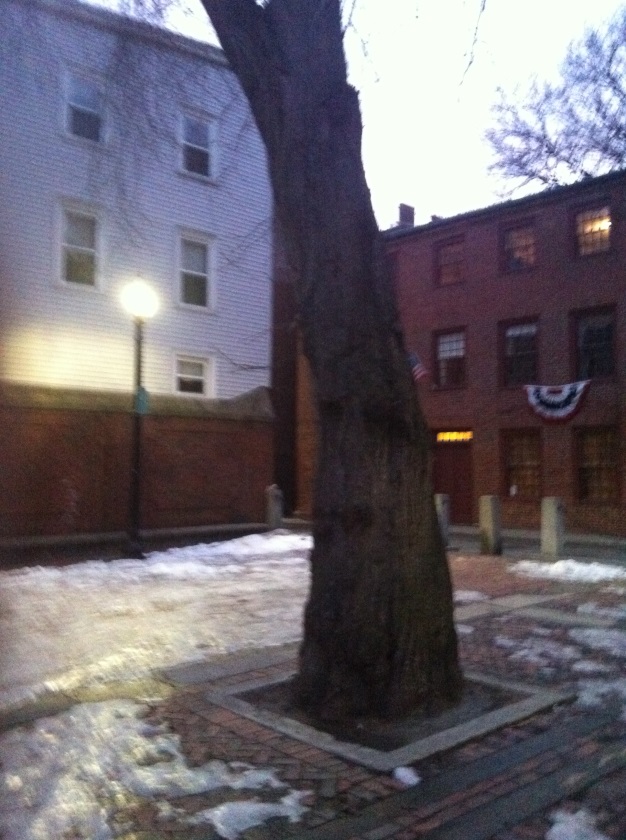 A robust tall three among the many
A robust tall three among the manythat thrive in the mall
There is, however, something even more interesting and peculiar regarding the brick bed in the mall. The mall contains several extremely big, tall, and old looking trees, and their excellent thriving calls for a lot of attention. The alignment of the trees is almost perfect; all of them grow straight and tall, without bending, and they are all about the same size and height, managing to grow at the same rate. This sort of flawlessness in nature is hard to come by in a city, and even more so in a public space as the Paul Revere mall. Indeed, as Spirn notes in The Granite Garden, "Some habitats are extremely stressful, and the range of plants that can survive within them quite narrow. [...] Unfortunately, the city's most valued public spaces are among the most stressful; streets, plazas, and parks can aggravate the worst problems of the urban environment." (p.175). The thriving of these trees therefore becomes even more puzzling when one considers the brick bed of the park over which they are planted. Taking a close look, it becomes evident that these huge trees are planted on a mere square whole on the brick bed, much like the small square of soil that the trees outside the mall in the sidewalks of Hanover Street get. The tree on the right is a generic sample of the trees in the Paul Revere mall. Even though it is planted in a very small square of soil, about the same size as that of the trees outside the park, its trunk has managed to grow immensely, to the extent that its width occupies almost the whole area of the square, and the tree has managed to thrive and grow very tall
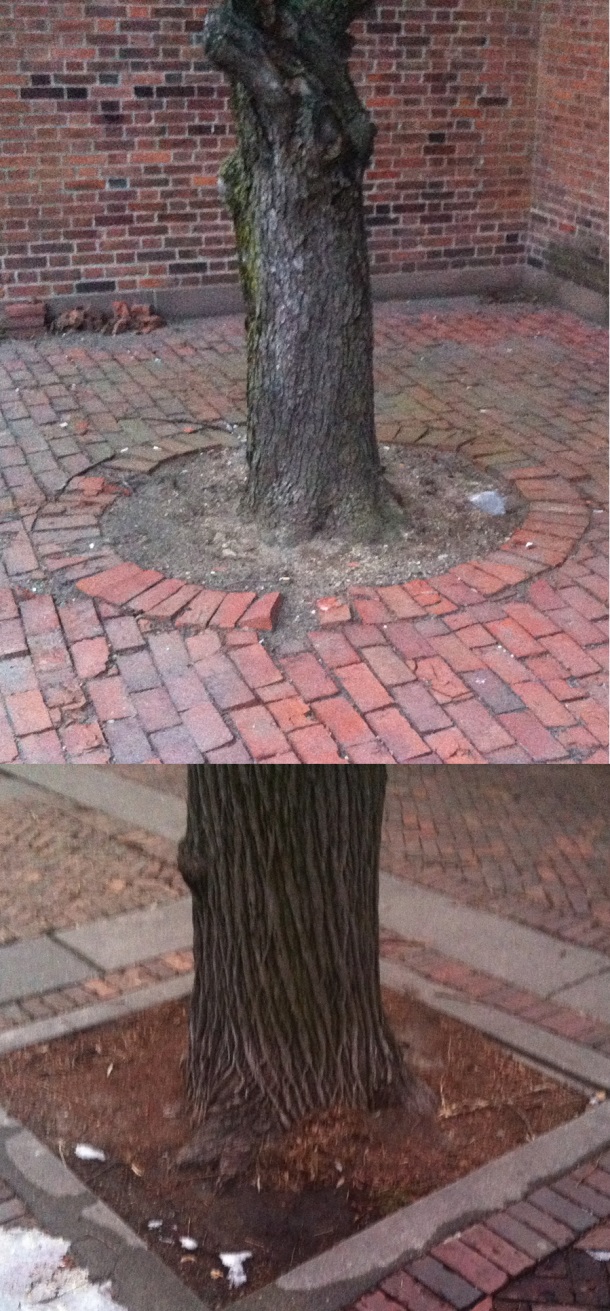 Even the petty tree near St Stephen's
Even the petty tree near St Stephen's Church (top) creates cracks in the floor
near its base, yet the trees in the mall
(bottom) seem to sit confortably in the
space they are given
Puzzling as this might be, it actually suggest there is a crucial distinction between the setting here and that on the outside. What could account for the difference in the success of the trees, given that the surface in which they are planted is almost identical? One viable conclusion that one might get to is that the surface looks identical, but the underground setting is very different. Could it be that, unlike the 'concrete pots' in the sidewalks, these trees actually have a large, uncontained bed of soil below them? This assumption would further be justified by the lack of cracks or deformations of the brick bed near the bases of the trees. Throughout North End, and really pretty much any urban area in general, one can notice how concrete potted trees will deform the terrain around them and form cracks on the concrete as they struggle to get out. The bricks that make up the surface of the Paul Revere mall seem particularly weak in terms of holding up together, so it would be reasonable to think that the roots of these trees do indeed have more space to grow deeper and wider, without having the need to attempt looking for space near the surface.
All of a sudden, this current day natural setting starts drawing our attention to the past. If the Paul Revere mall was indeed not built over concrete, but fertile soil, what could account for it? What was there in that large open area before, anyways, and how did they manage to clear it all at once for the construction of the mall?
All of a sudden, this current day natural setting starts drawing our attention to the past. If the Paul Revere mall was indeed not built over concrete, but fertile soil, what could account for it? What was there in that large open area before, anyways, and how did they manage to clear it all at once for the construction of the mall?
A little bit of research can actually confirm most of these suspicions. An article by Conor Finley on the North End Waterfront Webpage, under the title of "Prado History Part I: The Making of the 'Paul Revere Mall' " tells the story of this peculiar place. Indeed, the mall does happen to not be built over concrete, but instead has a wide, deep, and continuous bed of loam beneath its surface, which is most definitely responsible for the very notorious increase in the success rate of these trees. The answer to why there is a loam bed there rather than concrete and what laid there before that allowed them to manage to clear the whole space at once, however, is perhaps a little less subtle that one would like it to. The area where the mall resides today was once, unsurprisingly, a dense tenement housing complex. In 1933, however, the government simply decided they needed to give the neighborhood some air, so they went ahead and demolished the housing complex. In other words, what allowed them to clear that large area all at once was basically just power and brute force. Once they did that, keeping the idea of the future mall in mind, they removed part of the concrete and filled in the large bed of loan on which the park would be built. In the end, this is a very important example of how the current natural setting of the site can lead us to discoveries about the past, and how the setting itself has been continuously changing throughout the years. Below is a map of North End around the year 1743. The rough boundaries of the site are marked in red, and the present date location of the Paul Revere mall is shown in blue. Even though this was a long time before the events described, the housing complex where the mall would be built is already visible.
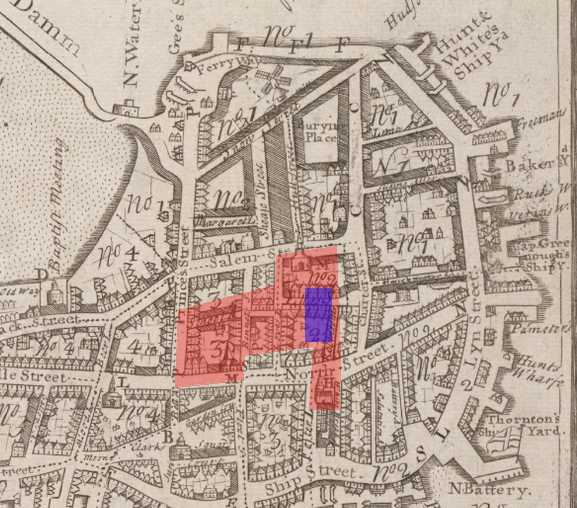 A map of North End, Boston by William Prince in 1743. Web. Wikimedia, http://commons.wikimedia.org/wiki/File:1743_NorthEnd_Boston_map_WilliamPrice.png . Accessed 7 March 2014.
A map of North End, Boston by William Prince in 1743. Web. Wikimedia, http://commons.wikimedia.org/wiki/File:1743_NorthEnd_Boston_map_WilliamPrice.png . Accessed 7 March 2014.
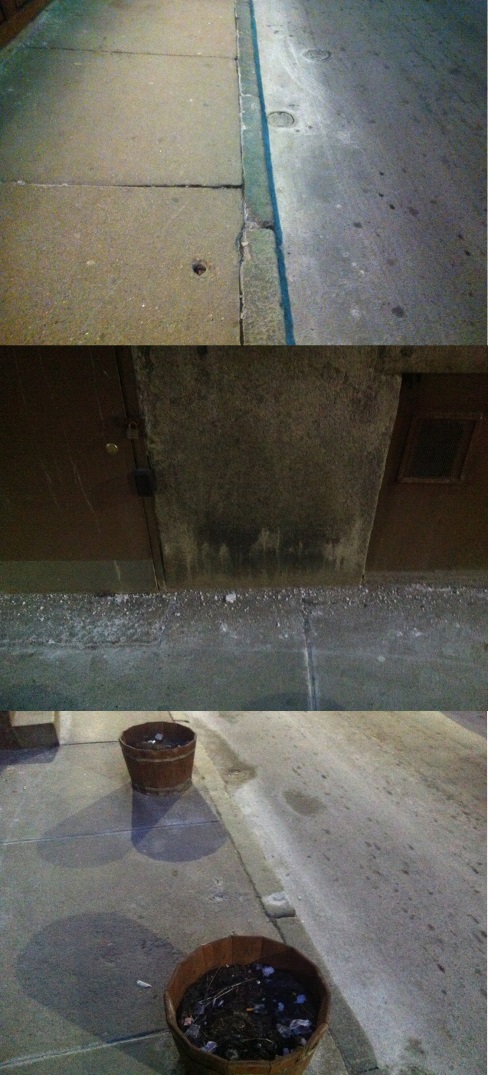 Pavement is deteriorated and facades are worn down an crumbling in Salem Street. One can find bush pots similar to the ones in Hanover Street, except these have not been successful and people have starter littering them
Pavement is deteriorated and facades are worn down an crumbling in Salem Street. One can find bush pots similar to the ones in Hanover Street, except these have not been successful and people have starter littering them
Finally, the last particular spot of interest in the present day setting of my site is Salem Street. When it comes to the natural setting, however, Salem Street is more notorious for its lack of it. This is a very narrow one way street that runs parallel to Hanover Street, the Paul Revere mall lying between them. Narrow as it is, there is almost no space at all for adornment as there is in Hanover, and one can walk several yards without encountering any tree or any form of vegetation whatsoever. In a sense, this is a little more representative of the general situation of the North End. Salem Street seems particularly forsaken, however. Cracks in the pavement are very common and seem to have accumulated without anyone ever fixing them. Other signs of erosion can be seen all over the place; walls are decolorized, facades are worn down and details on some stone engravings are heavily weathered. Overall, it creates a very strong contrast with Hanover Street, which attracts much more tourism and is thus more taken care of, so this signs are quickly fixed or concealed in it. Looking at Salem Street quickly takes us back to the reality, however, and it serves to remind us that the weathering and natural processes are there all the time, struggling to change how things look against human desire.
All in all, Boston is overall a place that has undergone remarkable changes in its setting in the course of the less than four hounded years since it was founded, due in part to human hands but also to countless and very powerful natural processes that have shaped and molded it, which have existed throughout and will continue to exists for years on end; and North End is one notable example of a zone where these makes themselves visible. Whether its trees cracking tons of concrete as they expand their roots in search for nutrients, moss growing on walls whenever it gets a chance, flat areas being inundated and eroded by water because of lack of proper drainage, or just hard stone buildings being deteriorated throughout the years and feeling the slow but constant effect of weathering, North End serves as a very strong example to show us that natural processes are always present, even in the most urbanized zones. Ignoring them would be a mistake, and improper consideration of them can lead to floods, overheating, deformed pavement in the streets, etc. In the end, humans will always have to plan accordingly to this everlasting force of change.
Bibliography:
- Spirn, Anne Whiston. The granite garden: urban nature and human design. New York: Basic Books, 1984.
- Elkins, James. How to use your eyes. New York: Routledge, 2000.
- Finley, Conor. Prado History Part I: The Making of the Paul Revere Mall. North End Waterfront. 26 Jan 2014, Web. http://northendwaterfront.com/2014/01/prado-history-part-i-the-making-of-the-paul-revere-mall/ (accessed March 7, 2014).
- A new sourvey of the harbor of Bsoton in New England. (London, crica 1706-1732). Web. Boston Rare Maps, http://www.bostonraremaps.com/catalogues/BRM1759.HTM . Accessed 7 March 2014.
- Boston, MA. Google Maps. Google, 6 March 2014. Web. Accessed 7 March 2014.
- A map of North End, Boston by William Prince in 1743. Web. Wikimedia, http://commons.wikimedia.org/wiki/File:1743_NorthEnd_Boston_map_WilliamPrice.png . Accessed 7 March 2014.